Mon people
The Mon (Mon: မန် or မည်; Burmese: မွန်လူမျိုး, pronounced [mʊ̀ɰ̃ lù mjó]; Khmer: មន, Thai: มอญ, pronounced [mɔ̄ːn] ![]() listen ) are a Southeast Asian ethnic group who inhabit Myanmar's Mon State, Bago Region, the Irrawaddy Delta, the southern Myanmar border with Thailand, and Thailand's Thon Buri District, Pakret District, Phra Pradaeng District and Lat Krabang District.[2][3]
listen ) are a Southeast Asian ethnic group who inhabit Myanmar's Mon State, Bago Region, the Irrawaddy Delta, the southern Myanmar border with Thailand, and Thailand's Thon Buri District, Pakret District, Phra Pradaeng District and Lat Krabang District.[2][3]
မန်, မောန်, မည် | |
|---|---|
.svg.png.webp) | |
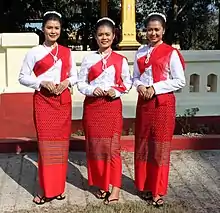 Mon girls in traditional dress, Mawlamyaing, Myanmar | |
| Total population | |
| c. 1.2 million | |
| Regions with significant populations | |
| c. 1.1 million[lower-alpha 1][1] | |
| 100,000 | |
| Languages | |
| Mon, Burmese, Thai | |
| Religion | |
| Theravada Buddhism | |
| Related ethnic groups | |
| Austroasiatic peoples | |
The Mon were one of the earliest to reside in Southeast Asia, and were responsible for the spread of Theravada Buddhism in Mainland Southeast Asia. The civilisations founded by the Mon were some of the earliest in Thailand as well as Myanmar.[4]
They speak the Mon language, an Austroasiatic language, and share a common origin with the Nyah Kur people of Thailand; they are from the Mon mandala (polity) of Dvaravati. A number of languages in Mainland Southeast Asia are influenced by the Mon language.[5] The Mon were a source of influence on the culture of Myanmar and Thailand. The Mon are regarded as a large exporter of Southeast Asian culture.[6] Historically, many cities in both countries today, including Yangon and Bangkok were founded either by the Mon people or Mon rulers.
Nowadays, the Mon are a major ethnic group in Myanmar and a minor ethnic group in Thailand.[7] The Mons from Myanmar are called Burmese Mon or Myanmar Mon. The Mons from Thailand are referred as Thai-Raman or Thai Mon.[3][8][9] The Mon dialects of Thailand and Myanmar are mutually intelligible.[10]
Exonyms and endonyms
In the Burmese language, the term Mon မွန် (pronounced [mʊ̀ɰ̃]) is used. During the pre-colonial era, the Burmese used the term Talaing (တလိုင်း), which was subsequently adopted by the British, who also invariably referred to the Mon as Peguans, during the colonial era.[11] The etymology of Talaing is debated; it may be derived from Telangana or Kalinga, a geographic region in southeast India.[12] The use of "Talaing" predates the Burmese conquest of the Hanthawaddy Kingdom in the 1700s and has been found on inscriptions dating to the reign of Anawrahta in the 1000s.[12][13] In 1930 and 1947, Mon ethnic leaders, who considered the term "Talaing" to be pejorative, petitioned against the use of the term. "Talaing" is now obsolete in modern Burmese, except in the context of specific historical terms, such as the eponymous song genre in the Mahagita, the corpus of Burmese classical songs. The Burmese term "Mon" is synonymous with the Burmese word for "noble."[14] In the Mon language, the Mon are known as the Mon (spelt မောန် or မန် and pronounced /mòn/), based on the Pali term Rāmañña (ရာမည), which refers to the Mon heartland along the Burmese coast.[15] In classical Mon literature, they are known as the Raman (ရာမန်).[11]
The Mon of Myanmar are divided into three sub-groups based on their ancestral region in Lower Myanmar:
History
Early history

The Mon people possibly started migrating down from China into the Indochina area in about 3,000 BC.[17] The Mon were believed to be one of the earliest peoples of Indochina. They founded some of the earliest civilizations there, including Dvaravati in Central Thailand (whose culture proliferated into Isan), Sri Gotapura[18] in central Laos (modern Sikhottabong, Vientiane Prefecture) and Northeastern Thailand, Hariphunchai Kingdom in Northern Thailand and the Thaton Kingdom in Lower Burma.[19]:63,76–77 They were the first receivers of Theravada missionaries from Sri Lanka, in contrast to their Hindu contemporaries like the Khmer and Cham peoples. The Mon adopted the Pallava alphabet and the oldest form of the Mon script was found in a cave in modern Saraburi dating around 550 AD. Though no remains were found belonging to the Thaton Kingdom, it was mentioned widely in Bamar and Lanna chronicles. The legendary Queen Camadevi from the Chao Phraya River Valley, as told in the Northern Thai Chronicle Cāmadevivaṃsa and other sources, came to rule as the first queen of Hariphunchai (modern Lamphun) kingdom around 800 AD.
After 1000 AD onwards, the Mon were under constant pressure with the Tai peoples migrating from the north and Khmer invasions from the Khmer Empire in the east. A significant portion of the Dvaravati Mons fled west to the present-day Lower Burma. The Mons of Dvaravati gave their way to the Lavo Kingdom by around 1000 AD. Descendants of the Dvaravati Mon people are the Nyah Kur people of present-day Isan. The Mon were killed in wars, transported as captives, or assimilated into new cultures. The Mon as an entity virtually disappeared in Chao Phraya Valley. However, Hariphunchai kingdom survived as a Mon outpost in northern Thailand under repeated harassment by the Northern Thai people.
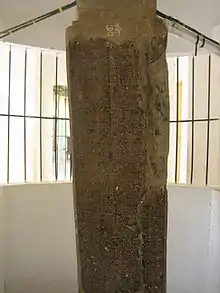
In 1057 AD, King Anawrahta of Pagan Kingdom conquered the Mon's Thaton Kingom in Lower Burma. The Mon culture and the Mon script were readily absorbed by the Bamar (Burmans) and the Mons, for the first time, came into Bamar hegemony. The Mon remained a majority in Lower Burma.
On the one hand, Mon's Hariphunchai Kingdom prospered in the reign of King Aditayaraj (around early twelfth century), who allegedly waged wars with Suryavarman II of Angkor (between 1113 and 1150 AD) and constructed the Hariphunchai stupa (in present-day Lamphun, northern Thailand). In 1230, Mangrai, the Northern Tai chief, conquered Hariphunchai and the Mon culture was integrated into Lan Na culture. The Lan Na adopted the Mon script and religion.
13th to 15th centuries
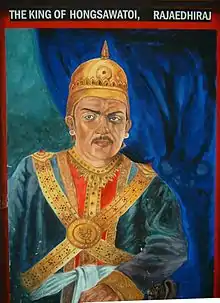
In 1287, the Pagan Kingdom collapsed, leaving the power vacuum. Wareru, who was born from a Mon mother and a Tai father, at Donwun Village in the Thaton District, went to Sukhothai for merchandise and later eloped with a daughter of the king. He established himself in Mottama and was proclaimed king of the Mon. The capital was later moved to Pegu (Bago). His Hanthawaddy Kingdom (1287–1539) was a prosperous period for the Mon in both power and culture. The Mon were consolidated under King Rajathiraj (1383–1422), who successfully fended off invasions by the Ava Kingdom. The reigns of Queen Shin Sawbu (1453–1472) and King Dhammazedi (1472–1492) were a time of peace and prosperity.
16th to 17th centuries
The Bamar, however, regained their momentum at Taungoo in the early sixteenth century. Hanthawaddy (Hongsawadee) fell to the invasion of King Tabinshwehti of Taungoo in 1539. After the death of the king, the Mon were temporarily freed from Bamar rule by Smim Htaw, but they were defeated by King Bayinnaung of Taungoo in 1551. The Bamar moved their capital to the former Mon's Hanthawaddy capital, Pegu (Bago), keeping the Mon in contact with royal authority. Over the next two hundred years, the Mon of Lower Burma came under Bamar rule.
Under Bamar rule, Lower Burma became effectively warfronts between the Bamar, the Thai and the Rakhine. After the passing of Bayinnaung, his son King Nanda of Toungoo Empire used more oppressed rules against Mon people. In 1584, King Nanda secretly sent two Mon chiefs; Phraya Kiat and Phraya Ram to assassinate Naresuan of Phitsanulok in Kraeng. Upon learning Naresuan was not at fault, Phraya Kiat and Phraya Ram joined Naresuan's campaigns against the Bamar's Toungoo court.[20] Then, the Mon were, either forced or voluntarily, moved to Ayutthaya (now Siam or Thailand). The collapse of Mon power propagated waves of migration into Siam, where they were permitted to live in the city of Ayutthaya. A Mon monk became a chief advisor to King Naresuan.
Pegu (Bago), the capital of Toungoo Empire was plundered by the Rakhine in 1599. Bamar authority collapsed and the Mon loosely established themselves around Mottama (Martaban). Following reunification under King Anaukpetlun in 1616, the Mon once again came under Bamar hegemony. The Mon rebelled in 1661 but the rebellion was put down by King Pye Min. Mon refugees were granted residence in western Siam by the Siamese king. The Mons then played a major role in Siamese military and politics. A special regiment was created for the Mon serving the Siamese kings.
18th to 19th centuries
Bamar power declined rapidly in the early eighteenth century. Finally, to restore their former Hanthawaddy (Hongsawadee) Kingdom, the Mon rebelled again at Bago in 1740 with the help of the Gwe Shan people. A monk with Taungoo royal lineage was proclaimed king of Bago and was later succeeded by Binnya Dala in 1747. With the French support, the Mon were able to establish an independent kingdom as Restored Hanthawaddy Kingdom before falling to the Bamar King Alaungpaya in 1757. Alaungpaya, the Bamar ruler U Aungzeya, invaded and devastated the kingdom, killing tens of thousands of Mon civilians, including learned Mon monks, pregnant women, and children. Over 3,000 Mon monks were massacred by the victorious Bamar soldiers in the capital city alone.[21][22][23] Thousands more monks were killed in the countryside. Alaungpaya's army was supported by the British army. This time, Bamar rule was harsh. The Mon were largely massacred, encouraging a large migration to Siam (Thailand) and Lanna. The Mon rebelled at Dagon in the reign of Hsinbyushin of the Konbaung Dynasty of Burma and the city was razed to the ground. Again in 1814, the Mons rebelled and were, as harshly as before, put down. These rebellions generated a huge wave of migrations of Mon people from Burma to Siam.
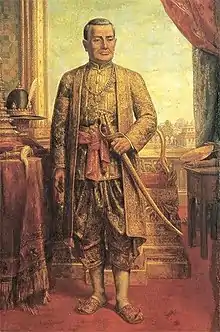
On the one hand in Siam side, after the fall of Ayutthaya in 1767, two descendants of Mon aristocrats who moved to Siam in 1584; Phraya Pichai and Phraya Chakri became the left and right-hand man of King Taksin of Thonburi, and they largely helped Taksin's campaigns in the liberation of Siam from Burmese occupation and reuniting Siam.[24] King Taksin himself also was a Sino-Mon descent and his maternal grandmother was a sister to chief of Siam's Mon community.
After the collapse of Taksin's Thonburi Kingdom, Phraya Chakri founded the Chakri Dynasty and ascended the throne in 1782 as Rama I. Rama I was born to Thongdi, a leading Mon nobleman serving the royal court in Ayutthaya in 1737.[25] Rama I's queen consort Amarindra was born to a wealthy Mon family who migrated to Siam in the earlier times. Rama I founded Bangkok City and moved the capital from Thonburi to Bangkok. When a huge wave of Mon migrations from Burma (now Myanmar) to Siam (now Thailand) happened in 1814, his grandson, the Prince Mongkut (later Rama IV) proceeded to welcome the Mon himself at the Siam-Burma border. Mongkut himself and the Chakri dynasty of Thailand today are of partial Mon ancestry.
The Mon in Thailand settled mainly in certain areas of Central Thailand, such as Pak Kret in Nonthaburi, Phra Pradaeng in Samut Prakan and Ban Pong, among other minor Mon settlements. Mon communities built their own Buddhist temples.[26] Over time, the Mons were effectively integrated into Siamese society and culture, although maintaining some of their traditions and identity.[27]
19th to 20th centuries
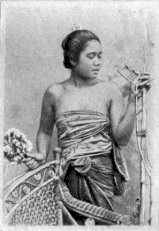
Burma was conquered by the British in a series of wars. After the Second Anglo-Burmese War in 1852, the Mon territories in Burma were completely under the control of the British. The British aided the Mons to free themselves from the rule of the Burman monarchy. Under Burman rule, the Mon people had been massacred after they lost their kingdom and many sought asylum in the Thai Kingdom. The British conquest of Burma allowed the Mon people to survive in Southern Burma.
In 1947, Mon National Day was created to celebrate the ancient founding of Hanthawady, the last Mon Kingdom, which had its seat in Pegu. (It follows the full moon on the 11th month of the Mon lunar calendar, except in Phrapadaeng, Thailand, where it is celebrated at Songkran).
The Mon soon became anti-colonialists. Following the grant of independence to Burma in 1948, they sought self-determination. U Nu, the first Prime Minister of Burma refused the Mon self-determination. Mon separatist groups have risen in revolt against the central Burmese government on a number of occasions, initially under the Mon People's Front and from 1962 through the New Mon State Party (NMSP). The BSSP-led government established a partially autonomous Mon State in 1974 out of portions of Tenasserim and Pegu regions. Resistance continued until 1995 when NMSP and ruling SLORC agreed a cease-fire and, in 1996, the Mon Unity League was founded.
21st century
Nowadays, the Mon are a major ethnic group in Myanmar and a minor ethnic group in Thailand.[7] The Mons from Myanmar are called Burmese Mon or Myanmar Mon. The Mons from Thailand (Siamese of ethnic Mon) are referred as Thai-Raman or Thai Mon.[3][8][9] A recent study shows that there is a close genetic relationship between central Thai and Mon people in Thailand.[28]
Due to the post-independence internal conflict in Myanmar, many ethnic Mon from conflict zones have migrated to the First World countries via the refugee camps along the Thai-Myanmar borders and in Malaysia. The Myanmar Mon refugee communities can be found in the United States (the largest community being in Fort Wayne, Indiana and the second largest being Akron, Ohio), Australia, Canada, Norway, Denmark, Finland, Sweden, and the Netherlands.
Language and script
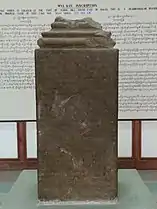
The Mon language is part of the Monic group of the Austroasiatic languages (also known as Mon–Khmer language family), closely related to the Nyah Kur language and more distantly related to Khmer and Vietnamese. The writing system is based on Indic scripts. The Mon language is one of the earliest documented vernacular languages of Mainland Southeast Asia.
Many languages in the region have been influenced by the Mon language. Tai Tham alphabet and Burmese alphabet are adaptations of the Mon script. Tai Tham alphabet is primarily used for Northern Thai language, Tai Lue language, Khün language and Lao Tham language. The Burmese alphabet is used for Burmese language, Shan language, S'gaw Karen language and other languages.
Historically, the Tai and Bamar adopted the Mon alphabet, which the Tai developed into their own writing systems as the Tai Tham alphabet, for the Thai Yuan people in the northern Thailand, and the Bamar developed Burmese alphabet, for the Burmese in Burma (Myanmar). Most scholarships believe that the Bamars adapted the Mon script for Burmese following their conquest of Mon's Thaton Kingom during Anawrahta's reign in the 11th century.[29]
Although Thais (Central and Southern Thailand) adopted more features from the Khmer alphabet than from the Mon, plenty of vocabulary in Thai language today were derived from the Mon language.[30][31][5] Burmese has derived and borrowed vocabulary from the Mon language, especially related to administration, architecture, cloth, cuisine and flowers.
Nowadays, the Mon language is recognised as an indigenous language in both Myanmar and Thailand. Due to the fall in number of Mon language speakers in the recent decades, Mon was classified as a "vulnerable" language in UNESCO's 2010 Atlas of the World’s Languages in Danger.[32]
Traditional culture
Symbol

The symbol of the Mon people is the hongsa (Mon: ဟံသာ, [hɔŋsa]), a mythological water bird that is often illustrated as a swan. It is commonly known by its Burmese name, hintha (Burmese: ဟင်္သာ, IPA: [hɪ́ɰ̃θà]) or its Thai name: hong (หงส์). The hongsa is the state symbol of Myanmar's Bago Region and Mon State, two historical Mon strongholds. Also, the hongsa is the city symbol of Thailand's Pak Kret City, a historical Mon settlement area.
Music and festivals

Mon culture and traditional heritages includes spiritual dances, musical instruments such as the kyam or "crocodile xylophone", the la gyan hsaing gong chime, the saung harp and a flat stringed instrument. Mon dances are usually played in a formal theater or sometimes in an informal district of any village. The dances are followed by background music using a circular set of tuned drums and claps, crocodile xylophone, gongs, flute, flat guitar, harp, etc.
During Songkran festival in Thailand, the Mon residents of Phra Pradaeng District hosts very unique Mon traditional ceremonies and folklore performances.[33]
Costumes
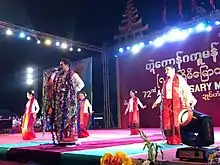
Mon women wear traditional shawl-like Sbai, known as Yat Toot in Mon language, diagonally over the chest covering one shoulder with one end dropping behind the back. This tradition distinguished Mon women from other 134 ethnic groups in Myanmar. Archaeological evidence from the Dvaravati era portrays that Dvaravati ladies wearing what seems to be a piece of Sbai hanging from their shoulder.[34] Mon people of Myanmar and Thailand today are the descendants of Dvaravati.
Mon men in Myanmar wear clothes similar to the Bamars. Those living in Thailand have adopted Thai style garments. It seems that Mon clothing has been shaped through its dynastic traditions as well as external influences.
Cuisines
Mon cuisines and culinary traditions have had significant influences on the Burmese cuisine and Central Thai cuisine today. Some of dishes that are now popular in Myanmar (Burma) and Thailand were originally Mon dishes. For example, Htamanè (ထမနဲ) in Myanmar, and Khanom chin (ขนมจีน) and Khao chae (ข้าวแช่) in Thailand.
Khao chae or Thingyan Htamin
A traditional Mon dish served with rice soaked with cool candle-and-jasmine-scented water is consumed by the Mon people during the Thingyan (Songkran) Festival in the summer. In Thailand, the dish is known as Khao chae (ข้าวแช่) and was considered "royal cuisine".[35][36] As the dish is served during Thingyan as part of their merit-making, it is known as Thingyan rice (သင်္ကြန်ထမင်း) in Myanmar today.[37]
Traditional games
Many games in both Myanmar and Thailand were Mon origins. Among them, Len Saba (lit. 'saba tossing game'; Mon: ဝိုင်မ်ဟနဂ်; Burmese: ဂုံညင်းဒိုး), Lor Kon Krok (Rolling a Mortar Bottom) and Mon Son Pa (Mon Hides a Cloth) are the most famous Mon traditional children games and are recognised as Intangible cultural heritage by UNSECO.[38][39]
List of notable Mon people
- Shin Arahan – primate who spread Theravada Buddhism in Bagan Kingdom and mainland Southeast Asia
- Wareru – founder of the Hanthawaddy Kingdom and Wareru Dhammathat, the oldest extant legal treatises of Myanmar
- Shin Sawbu – the only female ruler in the recorded history of Burma (now Myanmar)
- Binnya Dala – Chief Minister-General responsible for the expansion of Toungoo Empire, the largest empire in the history of Southeast Asia
- Osoet Pegua – an influential businesswoman in the Ayutthaya Kingdom in the mid-17th century
- Taksin – founder of the Thonburi dynasty of Siam
- Rama I – founder of the reigning Chakri dynasty of Siam (now Thailand)
- Amarindra – Queen consort of King Rama I and mother of King Rama II
- Chulalongkorn (Rama V) – the fifth monarch of Chakri dynasty who modernised Thailand
- Debsirindra – Queen consort of Rama IV and mother of Chulalongkorn (Rama V)
- Shaw Loo – the first medical doctor from Myanmar and the first Myanmar in the U.S
- Sir J A Maung Gyi – Governor of British Burma
- Min Thu Wun – a pioneer of literary movement in the 1930s and father of President Htin Kyaw (2016– 2018)
- Htoo Ein Thin – Myanmar pop singer
- Palmy – Thai pop singer
- Nandar Hlaing – Myanmar film actress
- Chintara Sukapatana - Thai film actress
- Natapohn Tameeruks - Thai film actress and model
- Srirasmi Suwadee – the third princess consort of then-Crown Prince Maha Vajiralongkorn (now Rama X) of Thailand
- Anand Panyarachun – Prime Minister of Thailand[40]
- Myint Swe – Vice-President of Myanmar
Gallery
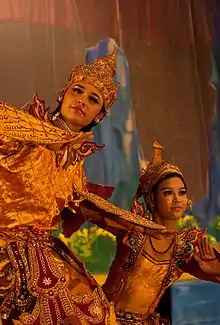 A theatrical performance of the Mon dance
A theatrical performance of the Mon dance_(3771128467).jpg.webp) Mon musical instruments
Mon musical instruments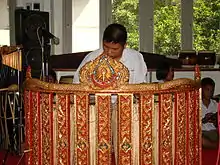 A student playing Mon Drum in Thailand
A student playing Mon Drum in Thailand Mon banana pudding
Mon banana pudding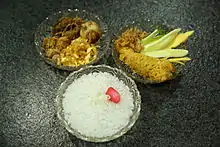 Mon inspired Khao Chae
Mon inspired Khao Chae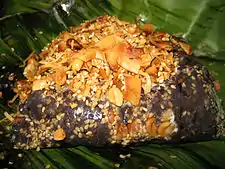 Htamanè glutinous rice
Htamanè glutinous rice.jpg.webp) Mon inspired Khao Khluk Kapi dish
Mon inspired Khao Khluk Kapi dish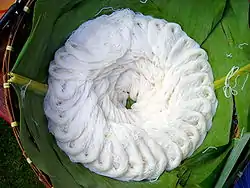 Khanom Chin rice noodles
Khanom Chin rice noodles Nga baung thohk (steamed fish dish wrapped in banana leaves)
Nga baung thohk (steamed fish dish wrapped in banana leaves).svg.png.webp) Hongsa (the symbol of Mon people)
Hongsa (the symbol of Mon people) Mon Traditional Flower-garlands
Mon Traditional Flower-garlands Celebration of Mon Youth Day in Myanmar (2019)
Celebration of Mon Youth Day in Myanmar (2019)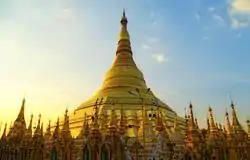
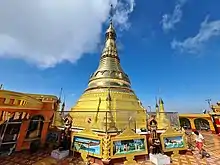
.jpg.webp) Mon-style Stupa in Nonthaburi, Thailand
Mon-style Stupa in Nonthaburi, Thailand
See also
Further reading
- 'Historic Lamphun: Capital of the Mon Kingdom of Haripunchai', in: Forbes, Andrew, and Henley, David, Ancient Chiang Mai Volume 4. Chiang Mai, Cognoscenti Books, 2012. ASIN: B006J541LE
Notes
- According to CIA Factbook, the Mon make up 2% of the total population of Myanmar (55 million) or approximately 1.1 million people.
- "The World Factbook". cia.gov. Retrieved 24 January 2018.
- "Mon, Thai minority who once ruled Southeast Asia". www.efe.com. Retrieved 2019-09-05.
- Foster, Brian (1973). "Ethnic Identity of the Mons in Thailand" (PDF). Journal of the Siam Society. 61: 203–226.
- "Thailand profile - timeline". BBC.
- Jenny, Mathias (January 2013). "The Mon language:recipient and donor between Burmese and Thai". Journal of Language and Culture. Research Institute for Languages and Cultures of Asia, Mahidol University: 19–20. doi:10.5167/uzh-81044.
- Desakura (2020-01-24). "Where does the Mon Pak Lad shortcut?". Stationremodel. Retrieved 2020-08-07.
- "Mon, Thai minority who once ruled Southeast Asia". www.efe.com. Retrieved 2019-09-10.
- Jenny, Mathias (2013). "The Mon language:recipient and donor between Burmese and Thai". Journal of Language and Culture. Research Institute for Languages and Cultures of Asia, Mahidol University. doi:10.5167/uzh-81044.
- Ngamying, Dusittorn (2014). "Mon Dance: Creating Standards to Continue the Performing Arts of Thai-Raman". Asian Culture and History. Canadian Center of Science and Education. 7. doi:10.5539/ach.v7n1p29.
- Wijeyewardene, Gehan (1990). Ethnic Groups Across National Boundaries in Mainland Southeast Asia. Institute of Southeast Asian Studies. p. 34. ISBN 9813035579.
- South, Ashley (2013-01-11). Mon Nationalism and Civil War in Burma: The Golden Sheldrake. Routledge. ISBN 9781136129629.
- Miscellaneous Notes on the Word "Talaing".
- Aung-Thwin, Michael A. (2005), Aung-Thwin, Michael A. (ed.), "The Mon Paradigm and the Myth of the "Downtrodden Talaing"", The Mists of Ramanna, The Legend That Was Lower Burma, University of Hawai'i Press: 261–280, ISBN 9780824828868, JSTOR j.ctt1wn0qs1.14
- "SEAlang Library Burmese Lexicography". sealang.net. Retrieved 2018-09-12.
- "Rāmañña - oi". Cite journal requires
|journal=(help) - Stewart 1937.
- Tun, Than. History of Burma in pictures.
- "Sri Gotapura". Archived from the original on 2014-10-31. Retrieved 2013-02-03.
- Coedès, George (1968). Walter F. Vella (ed.). The Indianized States of Southeast Asia. trans.Susan Brown Cowing. University of Hawaii Press. ISBN 978-0-8248-0368-1.
- Rajanubhab, Damrong (2001). Our Wars With the Burmese. Bangkok: White Lotus Co. Ltd. pp. 85–86. ISBN 9747534584.
- Kiernan, Ben (2008). Blood and Soil: Modern Genocide 1500-2000. Melbourne University. pp. 148–154. ISBN 9780522854770.
- Harvey, G E (2000). History of Burma. Asian Educational Services. p. 235. ISBN 9788120613652.
- Smith, Donald Eugene (2015). Religion and Politics in Burma. Princeton University Press. p. 35. ISBN 9781400878796.
- Roy, Edward (2018). Siamese Melting Pot. Flipside Digital Content Company Inc. ISBN 978-9814762854.
- Christopher, Baker (2014). A history of Thailand. Melbourne, Australia: Cambridge University Press. pp. 26 and 309. ISBN 9781316007334.
- Desakura (2020-05-27). "Wat Suthatham Temple in Samut Songkhram, Thailand". Stationremodel. Retrieved 2020-08-07.
- Wat's the centre of Mon tradition - Bangkok Post
- Srithawong, Suparat; Muisuk, Kanha; Srikummool, Metawee; Kampuansai, Jatupol; Pittayaporn, Pittayawat; Ruangchai, Sukhum; Liu, Dang; Kutanan, Wibhu (2020). "Close genetic relationship between central Thai and Mon people in Thailand revealed by autosomal microsatellites". Int J Legal Med. doi:10.1007/s00414-020-02290-4. PMID 32281021. S2CID 215741324.
- Harvey, G E (1925). History of Burma: From the Earliest Times to 10 March 1824. London: Frank Cass & Co. Ltd. p. 307.
- Baker, Christopher (2014). A history of Thailand. Melbourne, Australia: Cambridge University Press. pp. 3–4. ISBN 9781316007334.
- Haspelmath, Martin (2009). Loanwords in the World's Languages: A Comparative Handbook. Walter de Gruyter. p. 602. ISBN 978-3110218435.
- "UNESCO Atlas of the World's Languages in danger". UNESCO. Retrieved 2020-06-03.
- "Songkran 2020 in Thailand - Dates". rove.me. Retrieved 2019-09-04.
- "มรดกช่างศิลป์ไทย : งานปูนปั้น".
- Chirapongse, Kitty (2012). "It's khao chae season: How to eat Thailand's classic summer treat". CNN. Retrieved September 7, 2019.
- "A Guide to Royal Thai Cuisine". MICHELIN Guide. Retrieved 2019-09-07.
- "How to spend long Thingyan holidays". The Myanmar Times. 2017-04-07. Retrieved 2019-09-07.
- "Local Folk Games and Health Promotion: Case Study, Saba Tossing Game of Thai Raman People in Ongkarak District, Nakornnayok Province". 2019. SSRN 3335646. Cite journal requires
|journal=(help) - "Intangible Cultural Heritage". UNESCO Bangkok.
- ":: Kao Wao News Group". 2005-10-23. Archived from the original on 2005-10-23. Retrieved 2019-09-06.
References
- Nuchprayoon, Issarang; Louicharoen, Chalisa; Warisa Charoenvej (2007). "Glucose-6-phosphate dehydrogenase mutations in Mon and Burmese of southern Myanmar". Journal of Human Genetics. 53 (1): 48–54. doi:10.1007/s10038-007-0217-3. PMID 18046504. S2CID 22331704.
- Stewart, J. A. (1937). "The Song of the Three Mons". Bulletin of the School of Oriental Studies, University of London. Cambridge University Press on behalf of the School of Oriental and African Studies. 9 (1): 33–39. doi:10.1017/s0041977x00070725. JSTOR 608173.
External links
 Media related to Mon people at Wikimedia Commons
Media related to Mon people at Wikimedia Commons- Independent Mon News Agency
- Dating and Range of Mon Inscriptions
- Kao Wao News Group
- The Mon Information Home Page
- Mon state's profile
- Mon Music
.jpg.webp)
